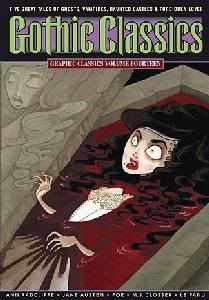| Pop Culture Gadabout | ||
|
Thursday, June 14, 2007 ( 6/14/2007 02:55:00 PM ) Bill S.  "AND NOW I SHALL NEVER BE ASHAMED OF LIKING UDOLPHO MYSELF!" – The cover to the most recent volume in the "Graphic Classics" series, Gothic Classics (Eureka Productions), depicts perhaps the most full-blooded moment in the collection: a scene from J. Sheridan Fanu's "Carmilla," showing the story's title vampiress lying in a leaden coffin filled with blood. Good stuff, indeed, for lovers of the outlandishly gothic, though unfortunately you'll search long through this 144-page collection to find another like it. "AND NOW I SHALL NEVER BE ASHAMED OF LIKING UDOLPHO MYSELF!" – The cover to the most recent volume in the "Graphic Classics" series, Gothic Classics (Eureka Productions), depicts perhaps the most full-blooded moment in the collection: a scene from J. Sheridan Fanu's "Carmilla," showing the story's title vampiress lying in a leaden coffin filled with blood. Good stuff, indeed, for lovers of the outlandishly gothic, though unfortunately you'll search long through this 144-page collection to find another like it.Edited by series mastermind Tom Pomplun, Gothic Classics contains adaptations of "Five Great Tales of Ghosts, Vampires, Haunted Castles & Forbidden Love!": "Carmilla," Ann Radcliffe's The Mysteries of Udolpho, Edgar Allan Poe's "The Oval Portrait," Jane Austen's Northanger Abbey, and M.J. Closser's "At the Gate." Of the five offerings, the most arguably successful are those that focus on shorter works: honing a beefy 18th–century novel like Udolpho or Northanger down to a 40-page comic mainly serves to heighten their haphazardness. In Rod Lott & Lisa K. Weber's retelling of the much-filmed horror tale "Carmilla," however, the focus remains on the story's bloody seductiveness (nicely captured by Weber's stylized penciling, which in places evokes a softer Richard Sala), while Pomplon & Malaysian artist Leong Wan Kok's four-page version of Poe's vignette smoothly catches the tone of this minor grim reflection on the obsessed artist. Of the three short pieces, only Pomplon & Shary Flenniken's "At the Gate" reads the most out of place as it isn't even a gothic short story. A sentimental tale of dogs in the afterlife, it really belongs in a different collection altogether (Animal Classics, perhaps), though it's an undeniable treat to see the "Trots And Bonnie" artist once more tackling expressive comic canines. Why isn't there a collection of this woman's underground and NatLamp work available? The two longer adaptations essentially play off each other: Austen's novel, adapted by Trina Robbins & Anne Timmons, was initially written as a parody of Udolpho, in fact – its primary joke (which wears thin long before the adaptation concludes, unfortunately) is to continually hint at impending perils which it never delivers. (David Chase is not the first writer to've pulled that particular trick!) While Robbins & Timmons both work mightily to recreate Austen's story, the source itself is such a filigreed trifle that after about twenty pages, you stop caring. Udolpho, for better or worse, is the template that centuries of romance writers have utilized to craft "ladies' gothics." It has everything you'd expect in a work of this type: a victim heroine thrown into the hands of villains by cruel fate, a crumbling castle with secret passages and a mysterious portrait, seemingly supernatural events that get "logically" explained (in this case, pirates are behind the seeming hauntings), poisonings, a wrongfully imprisoned dashing hero and more. If scripter Antonella Caputo is unavoidably text-heavy, Carlo Vergara's detailed art beautifully captures each teardrop and shadowy corridor. And while its plot isn't a model of air-tight construction, Udolpho's underlying theme – of women imperiled by an avaricious patriarchal culture – still holds it all together. In one of Northanger's better moments, novel-addled heroine Catharine Morland is shocked to learn that a handsome young gentleman is also fan of Udolpho: "You never read novels, I dare say," she states before learning the truth. "Gentlemen read better books." Despite its frequent status as second-class literature, gothic literature has endured, in part due to its transgressive disrespect for the niceties of realistic plotting. While Gothic Classics only occasionally touches on the genre's more sensationalist tendencies (you wanna do a truly gothic piece, why not adapt Castle of Otranto or, better yet, The Monk?), the sight of a willowy young girl holding onto a flickering lantern as she tremulously treads toward who-knows-what (check out Trina Robbins' back cover illo for a super-fine example of this image) is still rife with "forbidden" connotation . . . Labels: classics illustrated # | |
|
|

